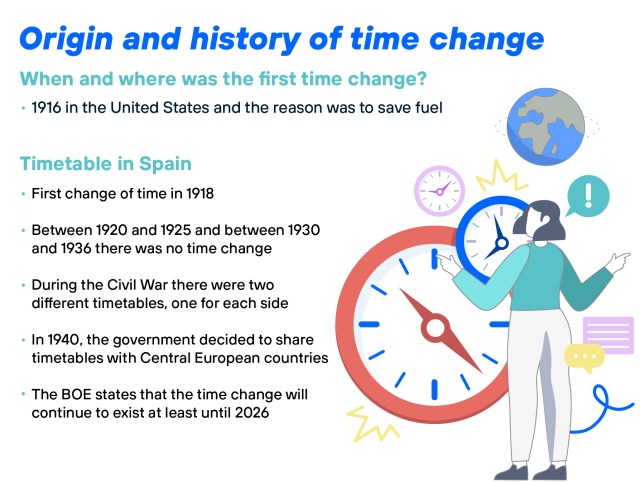For several years now, the time change and doubts about its continuity have been a recurring topic of conversation.
Change to Summer time 2025 in Spain
In the early hours of 29 to 30 March 2025, the time in Spain will change to Summer time. In this case, 02:00 will change to 03:00.
As we will see later, we know that the time change will be maintained until October 2026. After that date, we still do not know whether this biannual routine will become history or whether we will have to keep wondering whether we will have to sleep an hour more or less that night.
Origin and history of the time change
The American politician and scientist Benjamin Franklin (the inventor of the lightning rod, founding father of the United States and face of the US $100 note, among many other things) anonymously published an article in the Journal de Paris in the late 18th century explaining how Parisians could save candles by adapting their habits to daylight hours.
Franklin was followed by the English builder William Willet, who at the beginning of the 20th century broke down a series of cost-saving measures with a change of daylight saving time in summer. He came to this conclusion because he was used to riding his horse before breakfast and noticed that Londoners slept for several hours while it was already daylight. His proposal, to prevent the change from being too abrupt, was to change the clock in 20-minute weekly transitions.
Neither Franklin’s nor Willet’s proposal had immediate application, but they are considered the seed of what was to come. But when and where did the first time change take place? Well, it was in 1916 in the United States and the reason was to save fuel during the time of shortages caused by the First World War.
Timetables in Spain
Before going into detail about the history and evolution of time changes in Spain, it is interesting to know the evolution of time in our country.
At the beginning of the 20th century in Spain there were as many time zones as there were provinces, since the time was set by the sun, a reality that caused time lags of up to 42 minutes between one time zone and another. The radio news bulletins would have been quite entertaining if they had existed at that time…
But what brought about the unification of the timetable?
The development of the railways and the need to know the time to avoid collisions in the movement of trains led to the need to unify timetables.
In July 1900, Queen Maria Cristina of Habsburg-Lorraine (regent after the death of Alfonso XII fifteen years earlier) put an end to the problem by signing a decree that unified the time throughout Spain, including the Canary Islands (which would not become one hour behind mainland Spain until 1922), following the Greenwich Meridian. The decree was signed in 1900, although it did not come into force until 1 January 1901.
Time zone in Spain
Spain currently has two different time zones: one for the Canary Islands, which as we have just explained did not have a different time zone to the rest of the country until 1922, and another for the rest of the country.
The one in force on the Iberian Peninsula, the Balearic Islands, Ceuta and Melilla is known as CET (Central European Time), a name that comes from the English acronym that translates as Central European Time or Central European Time. This time zone has been in force since 1940 and we will see why later on.
For its part, the Canary Islands use WET (Wester European Time), which translates as Western European Time, a time zone shared with countries such as Ireland, Portugal and the United Kingdom.

History of the time change in Spain
The first time change in Spain took place in 1918, although it should be pointed out that neither between 1920 and 1925 nor between 1930 and 1936 did the time change. And it should be added that during the Civil War there were two different time zones, one for each side.
In 1940, Franco’s government decided that Spain should keep the same time as Nazi Germany and the countries of Central Europe, which has not been changed since then, while daylight saving time was revived in Spain and the rest of Europe in the 1970s due to the oil crisis.
And so we continue, with the question of how long the time change will be maintained. Officially, as stated in the Official State Gazette, the time change will continue to exist in our country until 2026.
And from then on… it is not known. Already in 2018 the European Commission, one of the main institutions of the EU, announced its intention to definitively cancel the time changes, allowing each country to choose the preference for summer or winter time.
Time change… until 2026?
But the truth is that we still have no certainty as to whether 2026 will be the last time we will have to move the hands of the clock forward (or backward). Something that Generation Z may not even know what we’re talking about…
The changeover to summer time in 2025 will take place on 30 March, while in 2026 we will change the time one day earlier, on 29 March.
As for winter time, in 2025 it will be 26 October and the following year it will be one day earlier, 25 October.
How the time change affects energy saving
As we have already mentioned in the section on origin and history, the first people who thought of changing the time did so as a proposal to save energy. But is the time change really effective from the point of view of energy saving?
There are studies, such as that of IDEA (Institute for Energy Diversification and Saving), which estimate that the time change can lead to energy savings of 5% of total consumption, although these are data from 2015 that have not been updated since then.
On the other hand, the Ministry for Energy Transition explained in 2019 that “there are no updated reports or proven experiences” that “allow us to assert that the time change is associated with energy savings”.
According to the ministry, “new energy efficiency requirements for lighting, building and air conditioning systems have significantly modified the data originally used to calculate energy savings”.
Although the time change was originally conceived as an energy saving measure for lighting, it is not so obvious for heating, which could even see its consumption increase, although it is difficult to measure due to the influence of external factors such as geography, meteorology or even user behaviour.
Thus, we can conclude that there is no consensus on whether the time change represents a significant energy saving.
How the time change affects your health
There is no unanimity among experts on the health effects of the time change. What is certain is that, from a physiological point of view, the time change alters the secretion of melatonin, a hormone that regulates sleep.
In addition to this change, working hours remain the same despite the time change, which means that, from a biological point of view, we wake up an hour earlier (it is one hour earlier with the October time change and one hour later with the March time change), thus breaking the sleep routine.
The effect this has on our bodies is similar to that caused by jet lag when travelling by plane to areas with different time zones.
The consequences for health can be varied, ranging from tiredness or fatigue to irritability, with a greater degree of affectation in children and older people, as it is people in these age groups who are more sensitive to hormonal changes.
In any case, the estimate is that in three days the body has become accustomed to the time change.
However, there are also experts who deny the negative effects on the body. The argument put forward is that this alteration could be negative for the human body if every day of the year dawned and set at the same time, something that, due to the tilt of the Earth, does not happen.
In fact, the tilt of the planet is precisely the reason why the countries closest to the equator have historically not needed to change the time since the difference in daylight hours throughout the day hardly varies during the year.Technology to synchronise the time change
Technology to synchronise the time change
Until a few years ago, changing the time meant changing the clocks at home. But that ritual stopped when our electronic devices started to automatically change the time.
But how does this automatic time change happen on our phones or computers? It happens thanks to NTP (Network Time Protocol), a protocol that synchronises the clocks of computer systems via the Internet or LAN.
The importance of NTP goes beyond the convenience of not having to be aware of the time change. It can be of great relevance in fields such as security, where there are devices that do not have” even a fraction of a second delay in certain computer systems.
As we have already noted above, the debate about the pros and cons of changing the time on the last weekends of March and October will continue in Spain until at least 2026. In the meantime, we will continue to hear (and ask) the same question: “So what, do we sleep one hour more or one hour less today?”














